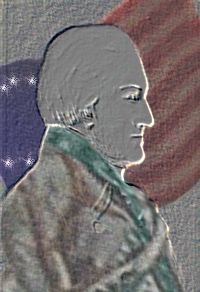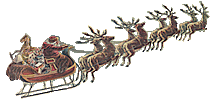November 18.-Set off from Lapraire l/2 after 12 o'clock
& with Major Dimon on foot & got to St. Johns at daylight.
November 2l.-Col'o Waterbury, Col'o Hobby, Major
Dimon 3 or 4 Captains and myself-on board the sloop.
The subalterns of Col. Waterbury's Regiment in the Row
Galley--& Col'o Ward of Gen'l Woosters Regiment on
board the Enemys schooner & each vessel1 full of soldiers,
set of from St. Johns with a small northerly gale & sleet, &
arrived at Isle Au Noix just before dark.
The Fortress of St. Johns lies near 130 miles North from
Ticonderoga on the brink of Lake Champlain St abt a quarter
of a mile from the first rapid. It consists of 2 forts or
redoubts near 100 yards asunder. The southern one rather
the largest. In this is a Brick house containing 2 clever
rooms $ Lintels back of them-& a small potash house
near it.
In the north redoubt is a very large white stone house 2
stories high but unfinished within, and now almost shattered
to pieces-almost too much so, ever to be repaired.
The forts are abt 100 feet wide each way in the inside; 8
mounted between them, upwards of 30 Iron Cannon besides
Brass field pieces (6 pounders) 8t several mortars.
The Wall is compos'd altogether of Earth, and neatly
sodded without, looking as green as the field around it.
The whole surrounded with a ditch of 7 feet deep & 8 or
9 feet wide-picketed on the Interiour side with timbers
projecting from under the wall & over the Ditch, & a little
elevated, with their points made very sharp.
Between the 2 forts there was a line of pickets placed (or
posts) 10 feet high and close together.
I imagine this was done to hinder the soldiers, who generally
did their cooking beyond them, from being seen from
the east Battery; and to secure their Bark Canoes from
Grape Shot as they lay also right behind them.
A Ditch was also dug deep enough for men to pass unseen
thro from one fort to the other, & between the pickets & the
Lake. Both the pickets & ditch were constructed after we
built our Eastern Battery.
In each Redoubt the Enemy kept a union display'd.
Its 2 or 300 yards from the Forts to the nearest woods or
bushes. In general its 5 or 600 to the woods-a low plain
wet, & covered with excellent grass surrounds the Fortress.
If there is any elevation of the earth at all, it is where the
forts stand.
The wilderness west of St. Johns is an impassable Quagmire-
Low, wet & covered with Timber & brush-& for 7 or
8 miles north of the fort we meet with but one sorry log
tenement which stood in our Grand camp.
Opposite the Forts on the east of the Lake The soil is
also very wet & low; a perfect howling swamp. There are
a considerable number of large Hemloc trees grow on this
side and plenty of the Balm of Gilead Firs. North east of
St. Johns at the distance of abt a mile stands a laree elegant
house belonging to oue Cap't Hasen with a conbsider-able
quantity of clear'd ground around it. The Captain
has a saw mill standing on the Rapids which are just by his
house. These Rapids are not so great but what rafts of
boards & timber can at any time go down them & so into
the River St. Lawrence. Our people frequently sent Battoes
down with Cannon in them-& empty ones can be drawn
up against the Current.
The fall is perhaps 100 yards in length. The breadth of
the Lake here as at St. Johns between 3 & 400 yards.
On the west side the lake, from St. Johns Northward
there are settlements all the way to Chamblee; a house or
two being in sight of the Fort.
From St. Johns to Chamblee is 10 miles-To Lapraire 18
--& to Isle Au Noix 15.
November 22.-A small breeze at S. W. all day and sleet
-made but 2 miles.
November 23-A very still day-Heard the news of the capture
of Carletons fleet & all on board except Carleton
himself and the few men who man'd the boat he ran away
in-made this day but 4 miles.
November 24.-Very calm-made but a mile to day.
November 25.-Made the Isle of Mott, and anchored near
the S. part of it & near the shore. In the night a snow
storm came on, the wind N. E.
November 26, Sunday.-As soon as daylight appeared we
weighed anchor, and under a very heavy Gale & but a rag of
the Mainsail hoisted stood up the Lake, snowing very fast all
the time, we no sooner lost sight of the Isle of Mott but we
were lost, and not a man'on board knew where we was till
3 in the afternoon when we were just by the 4 Brothers 30
miles perhaps from where we set of. In runing this distance
we were often in great danger, runing often but a few
rods from the rocky shores of Islands we never saw before
to remember again. Once between a couple of those Islands
we sounded and found the depth of water but 2 1/2 fathom.
As our vessel ran very fast and the sea went high, if we had
struck a rock, or even sand, our old crazy sloop must have
gone to pieces.
Abt half after 3 the weather cleared off a little, when we
espied the schooner just behind us. A little before Dark
we both of us dropt anchor quietly under the lee of Crownpoint.
The Row Galley had been there awaiting for us 2
days.
We ran this day abt 70 miles.
November 27.-This morning we hoisted & stood up
towards Ticonderoga That fortress being 15 miles from
Crownpoint-It being calm we row'd the vessells up. At
3 in the afternoon we arriv'd under the Fort & saluted it
with 13 guns-landed & waited on General Schuyler.
November 28.-Col'o Waterburys men carried over by
land two large Battoes from the bridge to Ticonderoga
landing, abt 2 miles-we lodg'd at Cap' Johnsons Quarters
at the landing-This evening I was seiz'd with a high fever.
November 29.-Early in the morning we set out in 3
Battoes on lake George on our way to the Fort of that
name. The wind being fresh at south we could get no
farther than Sabbathday point 12 miles from where we set
out where we spent the afternoon and night. The common
soldiers under trees and the Officers in a small log house.
At this place there are near 90 acres of land cleared; and
I believe the soil is good, as I observ'd the grass about the
house to be rank and good. One Richardson liv'd here,
till last spring when for fear of the Indians he mov'd down
to Fort George.
This is the only settlement between Ticonderoga landing
& Fort George.
November 30.- Set out early in the morning from Sabbathday
point, and row'd the whole day against a brisk southerly
wind; but by keeping amongst the Islands we evaded the
force of it much. Just before sunset landed at Fort George,
I was very sick all day & lying out in an open boat heightened
my disorder.
December 1.-This morning me set out from Fort George
3 Ox teams carrying our Baggage. On one of them I rode.
4 miles on the north of Fort Edward I b't a horse, being
too sick to ride on a Cart which the Teamster told me he
would be forc'd to use a few miles below Fort Edward for
want of snow for the sleds. Put up at Fort Edward at one
Pat Smiths, Co1 Waterbury and his party went forward 5
miles, & I never overtook them again. They had all my
Baggage with them.
December 2-I was very Ill when I set out from Smiths
and riding on a Bearskin without any stirrups, thro a small
snow too, did not contribute to alleviate my distemper. I
got as far as Saratoga & lodg'd at the Generals, Mrs. Schuyler
& her daughter being there.
December 3.-Travel'd down as far as Stillwater to Parson
Grahams where I stay'd a fortnight being too unwell to
proceed any Farther.
December 17, Sunday.-By proper attendance & the use of
the Bark I was well enough to set of from there the 17th
Sunday. I got as far as the new City that day.
December 18-Arrived in Albany at noon, & lodg'd at my
friend Mr. Jacob Rosabooms.
December 19.-Ferry'd across the river & got as far as
Kinderhook a little before sunset.
December 20.-Altho the weather was excessive cold &
the riding worse than I ever knew it, I reach'd Bests at
Kingsbridge before night, where I lodg'd.
December 21.-Rode down as far as Doct'r Bards where I
lodg'd. It being just sunset when I got there.
December 22.-A little after noon I arrived in safety at my
house. The God of all mercy be adored for his goodness
to an unworthy sinner!
[Fate of MontgomeryW7]



![]() Copyright © 2003, InterMedia Enterprises
Copyright © 2003, InterMedia Enterprises